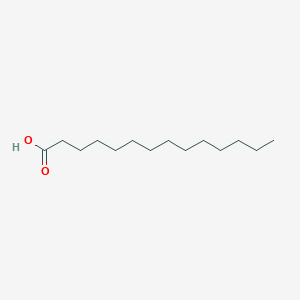| General Information of MET (ID: META00076) |
| Name |
Myristic acid
|
| Synonyms |
Click to Show/Hide Synonyms of This Metabolite
1-Tetradecanecarboxylate; 1-Tetradecanecarboxylic acid; 1-Tridecanecarboxylate; 1-Tridecanecarboxylic acid; 14; 14:00; Acid, myristic; Acid, tetradecanoic; Acide tetradecanoique; C14; CH3-[CH2]12-COOH; Crodacid; FA(14:0); Myristate; Myristic acid pure; Myristinsaeure; Myristoate; Myristoic acid; N-Tetradecan-1-Oate; N-Tetradecan-1-Oic acid; N-Tetradecanoate; N-Tetradecanoic acid; N-Tetradecoate; N-Tetradecoic acid; Tetradecanoate; Tetradecanoic (myristic) acid; Tetradecanoic acid; Tetradecoate; Tetradecoic acid
|
| Source |
Endogenous;Escherichia Coli Metabolite;Yeast Metabolite;Fatty acyls;Food;Drug;Toxins/Pollutant;Cosmetic;Food additives;TCM Ingredients;Pharmaceutical additive; Microbial
|
| Structure Type |
Fatty acids and conjugates (Click to Show/Hide the Complete Structure Type Hierarchy)
Lipids and lipid-like molecules
Fatty Acyls
Fatty acids and conjugates
|
| PubChem CID |
|
| HMDB ID |
|
| Formula |
C14H28O2
|
| Structure |
<iframe style="width: 300px; height: 300px;" frameborder="0" src="https://embed.molview.org/v1/?mode=balls&cid=11005"></iframe>
|
 |
|
3D MOL
|
2D MOL
|
|
Click to Show/Hide the Molecular/Functional Data (External Links/Property/Function) of This Metabolite
|
| KEGG ID |
|
| DrugBank ID |
|
| ChEBI ID |
|
| FooDB ID |
|
| ChemSpider ID |
|
| METLIN ID |
|
| Physicochemical Properties |
Molecular Weight |
228.37 |
Topological Polar Surface Area |
37.3 |
| XlogP |
5.3 |
Complexity |
155 |
| Heavy Atom Count |
16 |
Rotatable Bond Count |
12 |
| Hydrogen Bond Donor Count |
1 |
Hydrogen Bond Acceptor Count |
2 |
| Function |
Myristic acid is a saturated 14-carbon fatty acid occurring in most animal and vegetable fats, particularly butterfat, as well as coconut, palm, and nutmeg oils. It is used to synthesize flavour and as an ingredient in soaps and cosmetics (From Dorland, 28th ed). Myristic acid is also commonly added to a penultimate nitrogen terminus glycine in receptor-associated kinases to confer the membrane localization of the enzyme. This is achieved by the myristic acid having a high enough hydrophobicity to become incorporated into the fatty acyl core of the phospholipid bilayer of the plasma membrane of the eukaryotic cell.
|
|
Regulatory Network
|
|
|
|
|
|
|
|
|
 click to show the details of this protein
click to show the details of this protein
 click to show the details of experiment for validating this pair
click to show the details of experiment for validating this pair
 click to show the details of this protein
click to show the details of this protein
 click to show the details of experiment for validating this pair
click to show the details of experiment for validating this pair

